Montecito’s History of Violence
Past and Present Disasters Force Residents to Reconsider Rebuilding
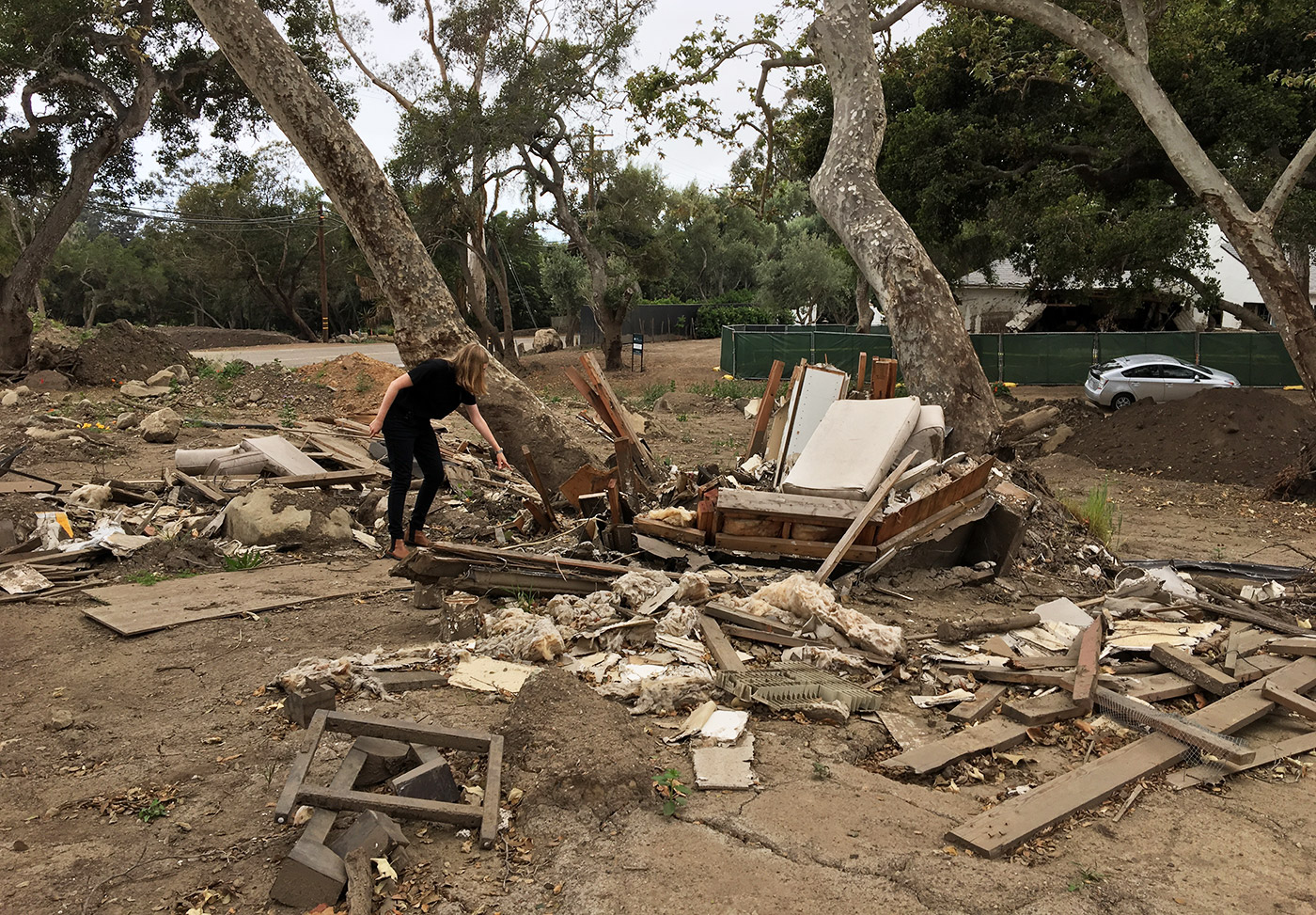
Nearly 50 years ago, when seven inches of rain fell in the mountains above Montecito in 12 hours, triggering “avalanches” in the canyons, they said it could be “the storm of the century.”
“Rocks weighing more than 30 tons ripped loose from the mountainside, clearing the canyons of everything in their path and jamming up behind bridges at critical locations,” the Santa Barbara News-Press reported. “One such jam occurred on the San Ysidro Creek bridge … causing the creek to breach its banks and flood homes on Glen Oaks Drive.”
It was the debris-laden flood of January 25, 1969, four years and five months after the Coyote Fire laid waste to the mountainside above Montecito. And it quickly overwhelmed the small debris basin that had been built after the fire in 1964.
Homes at 1774, 1775, and 1790 Glen Oaks were heavily damaged by mud and boulders, the News-Press said. A woman who stepped outside at 1775 Glen Oaks was swept away; she was pulled from the muck 12 hours later, clinging to the roots of a tree.
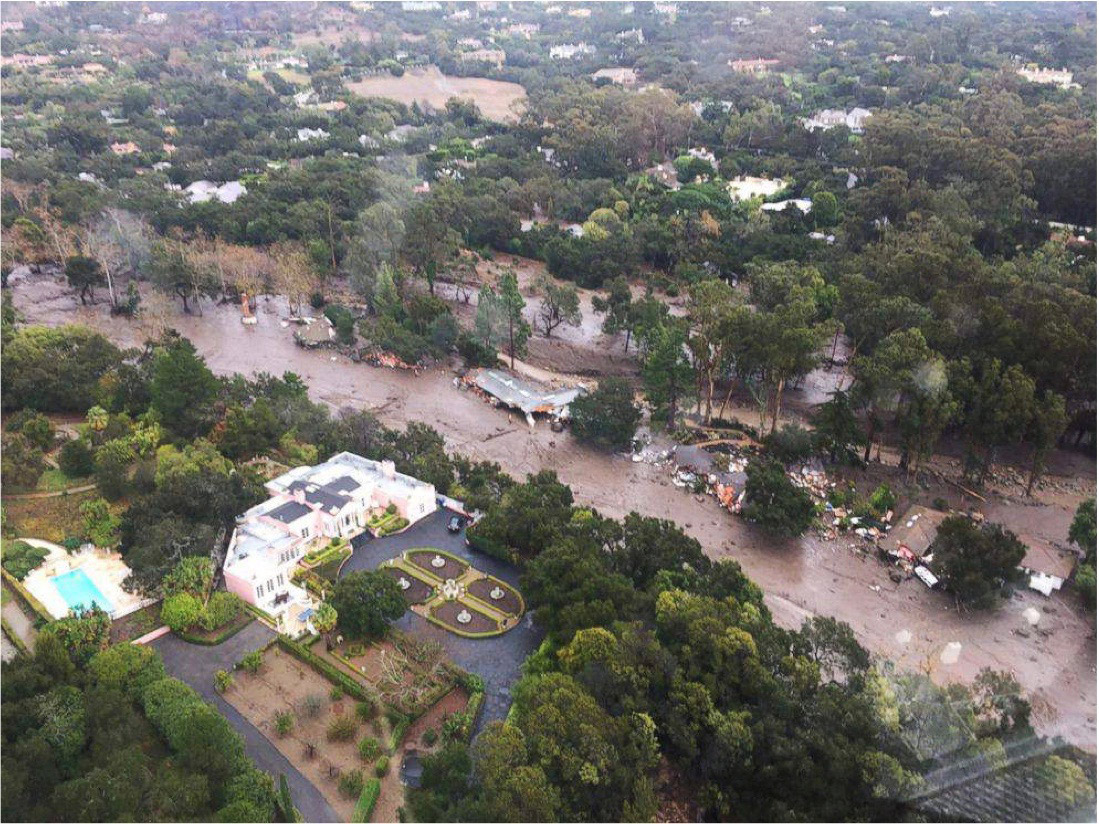
This January 9, the devastation was much worse. Four people in the neighborhood were swept away to their deaths. San Ysidro Creek jumped its banks at La Casa de Maria, a foothills retreat, briefly split into two rivers of mud and boulders, then rejoined downstream in one deadly flow.
Six out of seven homes on Randall Road were destroyed on January 9, including a house with a steel roof. The flow also damaged or destroyed three homes on East Valley Road, six homes on Glen Oaks and nine on East Valley Lane. Among them were two addresses that were hit in 1969, and one that was damaged in an earlier debris flow.
Today, the sloping, once thickly wooded terrain on either side of East Valley Road looks like a battle zone. As property owners relive and reflect on the deadly damage that was inflicted just a few months ago, some are giving consideration to history and wondering whether rebuilding is worth it or not. The debate raises crucial questions about whether there could be a technological fix, or whether efforts to stand in the way of nature are ultimately doomed.
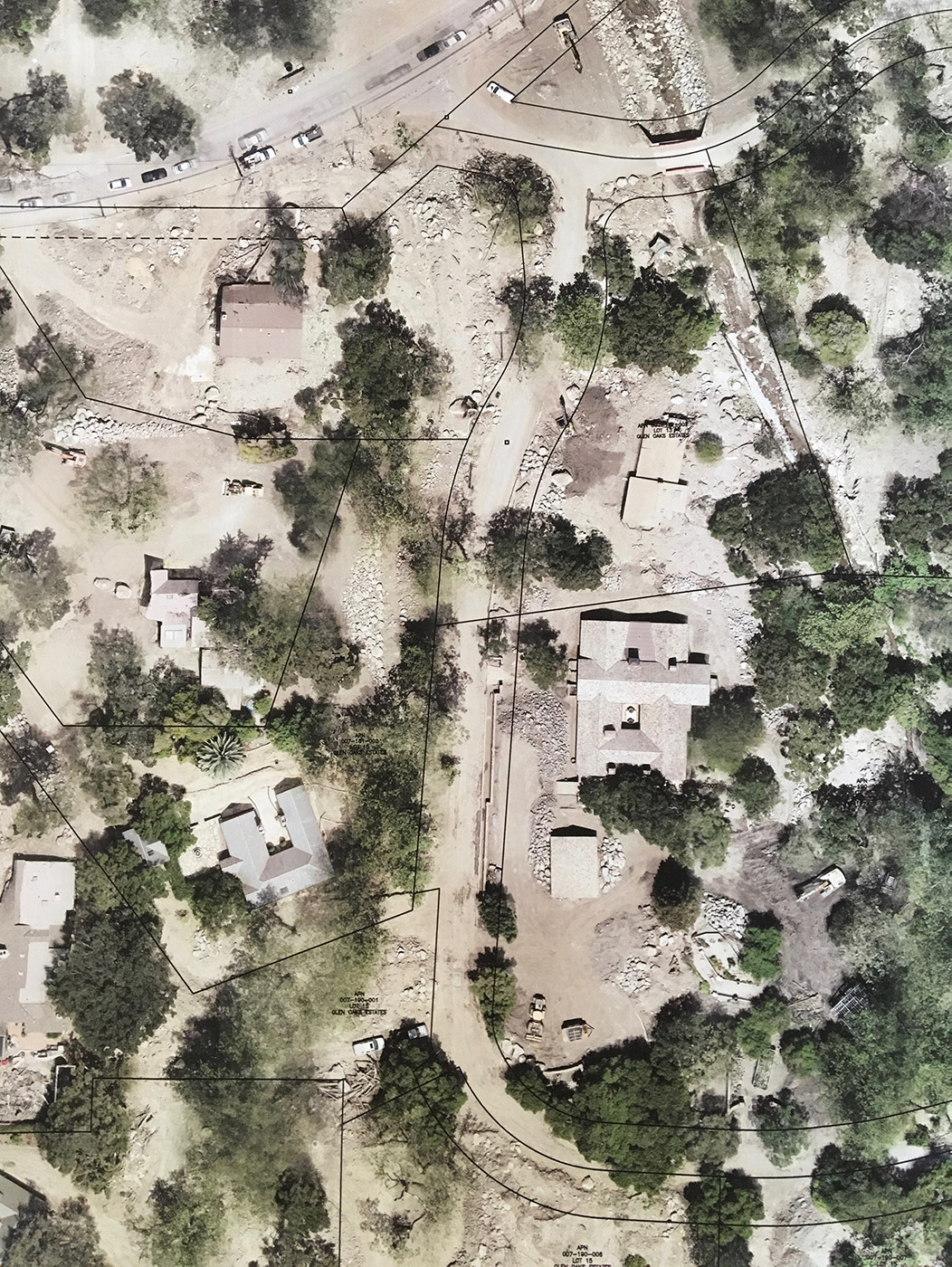
‘Beyond Apocalyptic’
Lynn Conrad-Armstrong, who slept through the disaster in a house built on caissons at 1780 Glen Oaks Drive, doesn’t need the newly released Federal Emergency Management Agency recovery map to decide what to do. She is hoping a philanthropist will buy her land as a park. Her home could be the clubhouse.
“I want out as fast as I can get,” she said. “I would never live here again, and I don’t think anybody should. Even if I lose money saying that, I can’t help but say it. Why have more people die this way?”
Conrad-Armstrong’s guest house at 1790 Glen Oaks was obliterated, but it may have buffered her home next door. The first floor at 1780 Glen Oaks is six feet above ground; the flow rushed through the basement and filled it with mud. Conrad-Armstrong was lucky; her immediate neighbors, Rebecca Riskin of 1799 Glen Oaks and Josie Gower of 1725 East Valley Road, perished in the disaster.
On Randall, a private road that extends uphill toward La Casa de Maria on the north side of East Valley Road, some owners are exploring whether they could sell their land for a debris basin to help protect homes below them — if a buyer can be found.
“I’m not sure anybody is committed to rebuilding,” said Victoria Riskin, Rebecca’s cousin, whose home at 680 Randall was dislodged from its foundations in the surging torrent of mud and rocks. Her roof slammed into the house next door.
“It was beyond apocalyptic,” Riskin said. “The neighbors would love to rebuild, but is it safe? Would someone want to buy all that? And if people are going to rebuild, would there be enough of them to make it a nice street again?”
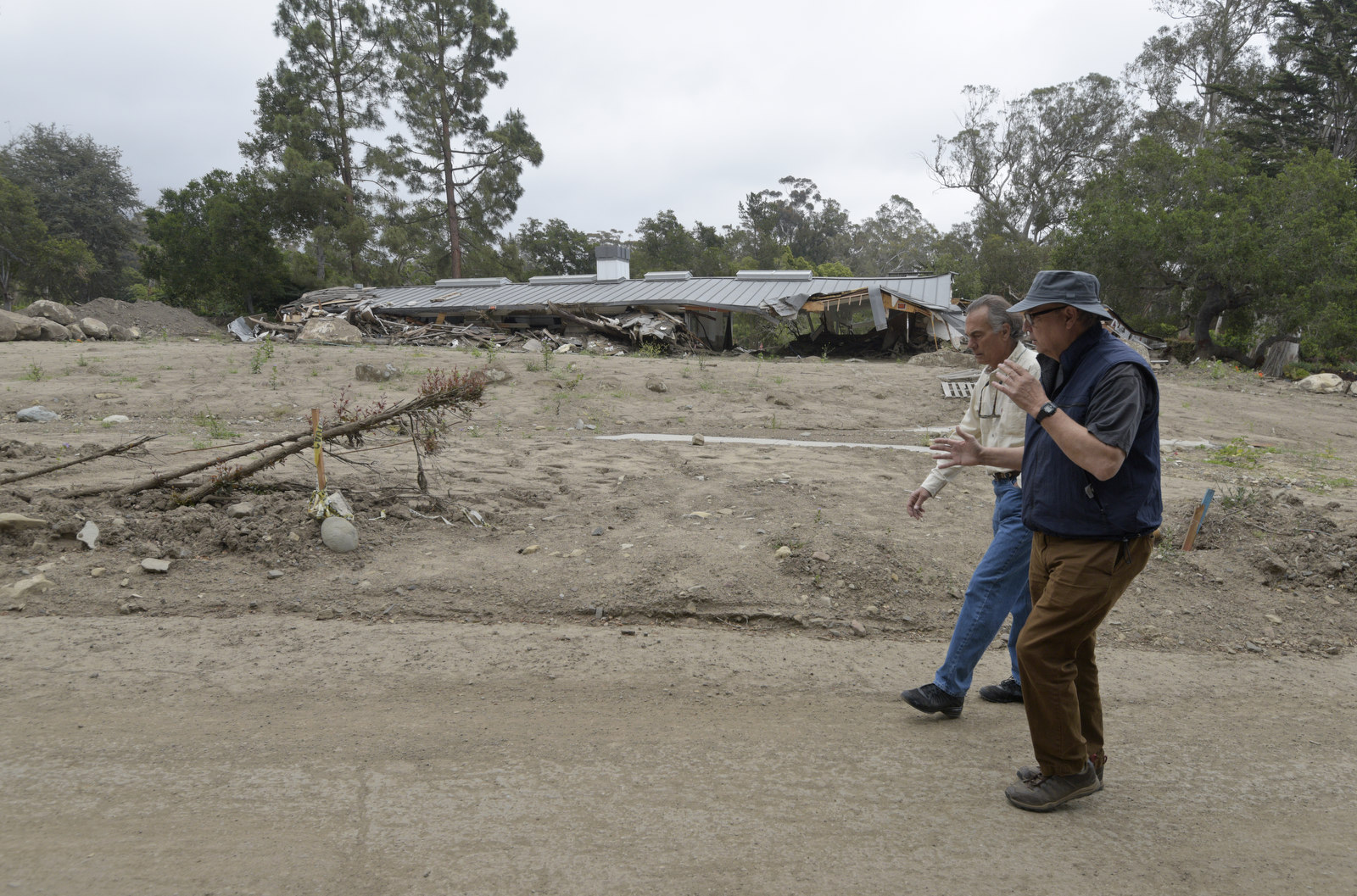
Curtis Skene, an unofficial spokesman for East Valley Lane property owners, recalled how the debris-laden flood of January 1969 filled his boyhood home at 1709 East Valley Lane with three feet of mud. This January 9, he barely escaped as a much bigger flow threatened to engulf him.
“A lot of us are still stuck in a silo of shock,” Skene said. “Just dealing with all my neighbors, I can tell you that they’re thinking one thing two months after the event; a month after that they’re thinking something different; and a month later, they’ll go, ‘I have no idea.’
“The likelihood is, we’re going to have another event. It may not be as big as the one we had this January, but it could come down here. It’s all very sobering.”
Sleep, Then Amnesia
In 2006, Conrad-Armstrong left behind a life of 45 years as a nun at the Vedanta Temple on Ladera Lane to marry James Darsie; they bought a home at 1780 Glen Oaks. Soon after, she bought the house next door at 1790 as an art studio for her late husband, knowing, she said, that it had been flooded with mud and debris in 1969. At the time, she said, she understood that the creek could rise but not that the mountainside could come down on her.
Conrad-Armstrong, who is 75, said she painstakingly cleared out her six-foot-high basement in preparation for the big storm on January 9. She took her dogs out for a walk about 1 a.m., then fell asleep on the couch. She did not hear the boulders crashing through the windows or the tumult of mud and rocks filling her basement.
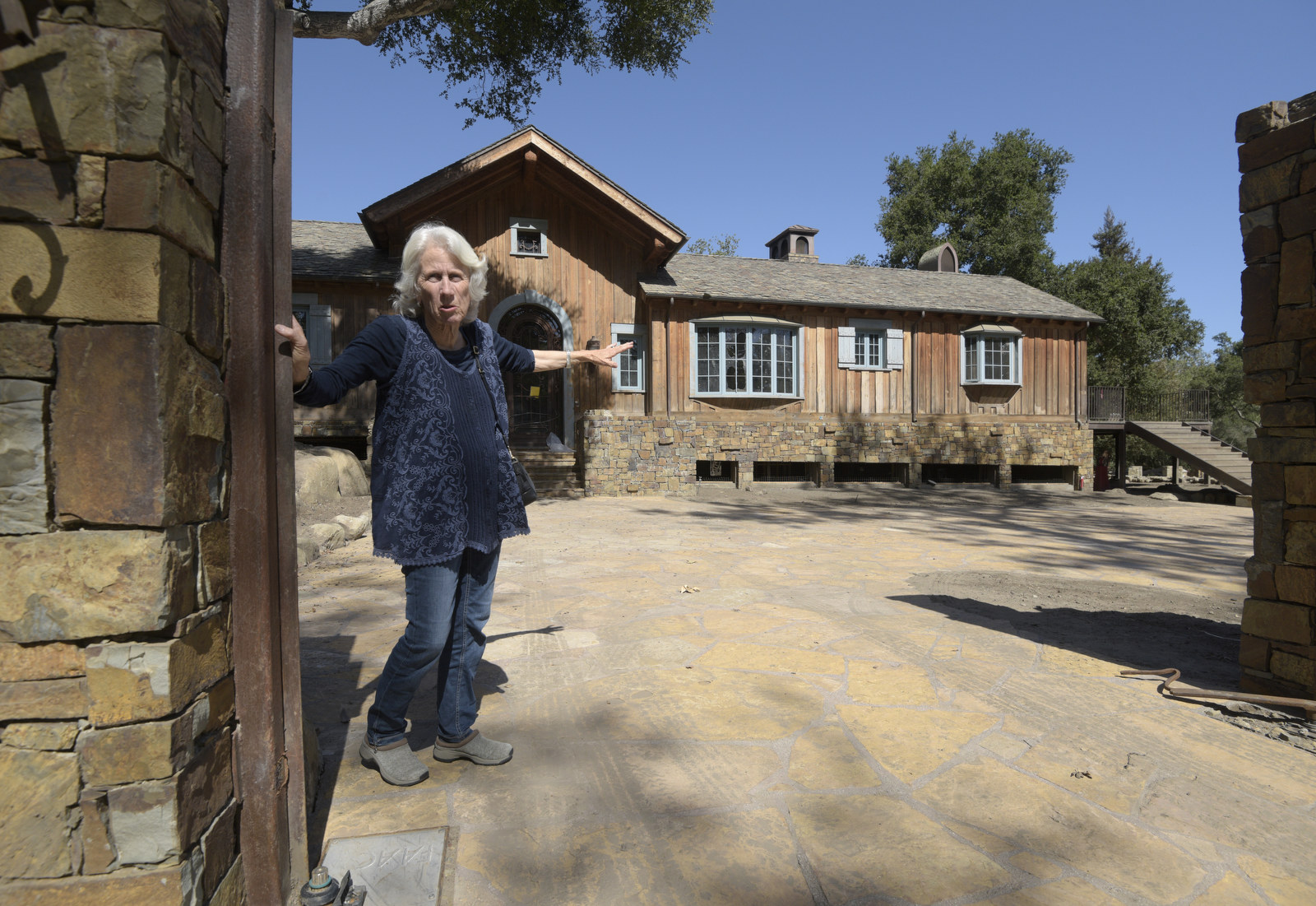
At 7 a.m., Conrad-Armstrong woke up, saw the mud oozing into her living room, opened her front door and went into shock. She remembers nothing about the intervening hours until 11 a.m., when she was airlifted out. From the evidence, she said, she was in her closet “packing, packing, packing” the whole time. “You don’t know who you are or where you are,” she said. When the rescue team arrived in yellow jackets, she greeted them with “Why are you here? There’s no fire.”
Conrad-Armstrong is staying in her old room at the temple; last week, she bought a house that is safely on a hill in Ennisbrook. She misses her four dogs; her large garden of ferns and jasmine, which she watered by hand; and her turtle pond.
“It was magnificent,” she said of her former estate. “Now, it’s not.”
Conrad-Armstrong’s house at 1780 Glen Oaks is being touted around Montecito as a model for safe creekside construction, but she wishes it had been swept away so that nobody could live in it again. Her insurance company, she said, won’t let her tear it down. She has had the mud cleaned out of the basement in preparation for selling the property — in case, she said, someone comes along who doesn’t believe there will be another debris flow anytime soon.
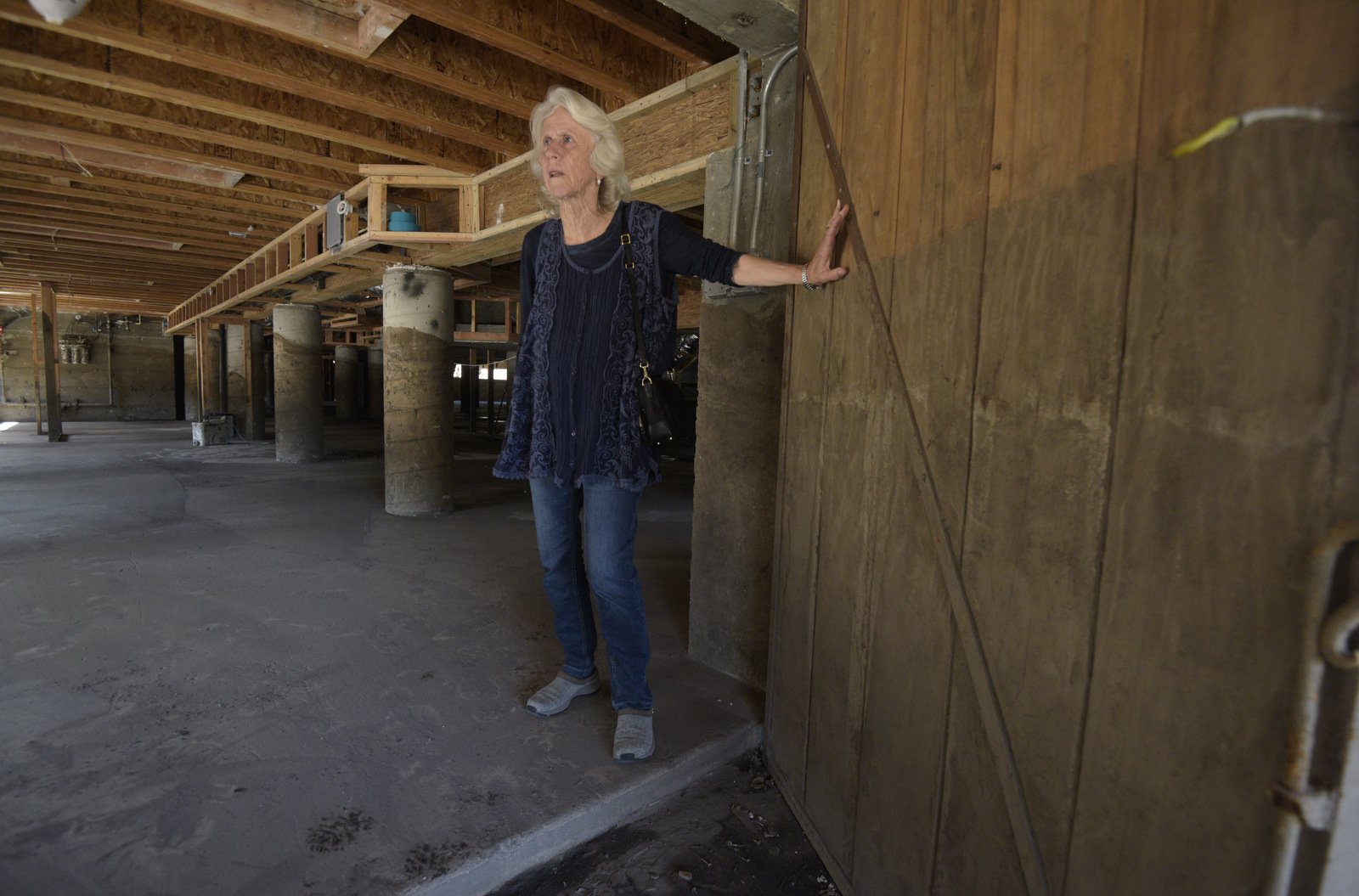
“I feel this is minor compared to what could really come down, if we got the right amount of rain,” Conrad-Armstrong said. “A lot of this is climate change, oh yes. It’s going to happen again because we’re in fire country. It’s going to keep on happening because of our topography.”
Conrad-Armstrong said she hopes to recoup about half of the $12 million she put into her homes and gardens. It would be “immoral” to sell her properties for residential use, she said, but she will if she has to.
“I will put it on the market with full disclosure for whatever they’ll give me,” she said. “One has to get some money from this disaster. One cannot go away penniless. People say, ‘Aren’t you going to move back?’ And I want to say, ‘Are you crazy?’
“My property should be a park. I want real action on this.”
‘A Roar Like Violent Thunder’
The neighborhood at Randall, East Valley Road, and Glen Oaks was one of the three deadliest places to be before dawn on January 9 in Montecito; 11 people died on the west bank of Montecito Creek, below the bridge at East Valley Road, and six died in the 300 block of Hot Springs Road.
But there were some close calls last century here, even before the debris-laden flood of 1969 — a taste of things to come.
On November 9, 1964, relatively light rains triggered a major debris flow just seven weeks after the Coyote Fire. Beginning at 6:40 a.m., the News-Press reported, the flow “was rolling boulders and tossing heavy timbers like matches.”
The paper ran a photo of a house at 1760 East Valley Road, next to San Ysidro Creek, with a smashed garage door and several feet of mud and debris in the dining room, bathroom, and front yard, according to the Morning News. The 1700 block of East Valley “looks more like the muddy Mississippi River than a roadway,” it said.
This January 9, a house at 1760 East Valley was totally destroyed.
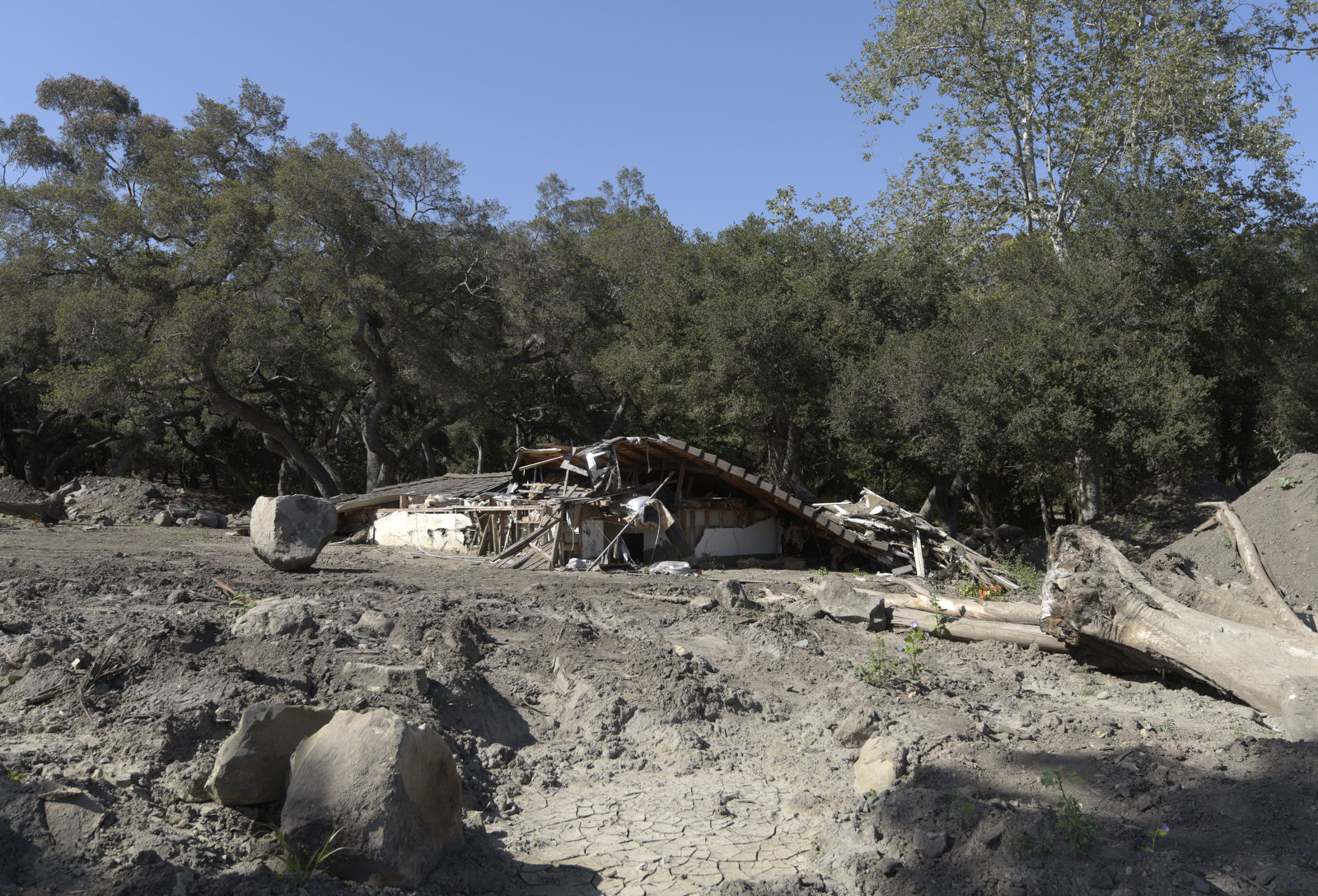
Flash back 90 years, and at 7:30 p.m. on February 11, 1926, four gardens at the Randall estate on East Valley were washed out as the family fled in terror and a limousine was dashed against a tree, the Morning News reported. The estate was piled high with mud and debris, and the paved road was broken to bits. The cause, the paper said, was the “formation of a dam high in the headwaters of San Ysidro Creek of trees, rocks and other debris, which suddenly went out when a large head of water gathered behind it …
“Residents reported a roar like violent thunder, accompanied by a quivering of the earth as if a heavy freight train were passing by.”
The debris flow of 1926 came two years after a wildfire on the slopes above Montecito. The Morning News reported that “heavy woods in the upper section of San Ysidro Creek broke the force of the torrent,” preventing more damage on San Leandro Lane and the Coast Highway.
The Randall estate was subdivided into one-acre lots in 1977; the original homestead at what is now 630 Randall Road was purchased in 1997 by Mark Montgomery, a Santa Barbara hand surgeon. As San Ysidro Creek jumped its banks this January 9, Montgomery and his daughter, Caroline, were swept away to their deaths in a catastrophic debris flow.
A Second Debris Basin?
Brian and Karen MacDonald, Montgomery’s neighbors immediately downstream at 620 Randall, had followed mandatory evacuation orders on January 8 and left their property next to the creek — just for the night, or so they thought. All that remains now of their home is a tangle of broken furniture and drywall wedged into the trunk of a sycamore tree. Mixed in are some pieces of twisted, colored canvas, remnants of a lifetime of Brian’s paintings.
The MacDonalds’ property, which was in a low spot, is now 10 feet higher because of all the mud that was deposited there. The forest of oak and sycamore trees that surrounded the homes on Randall has been stripped away, eerily opening up unsolicited ocean views.
“This has been emotionally scarring for us,” MacDonald said. “We love Montecito. We want Montecito to recover, and we believe it will get rebuilt. But we don’t know if we’ll be part of that recovery.”
Across East Valley Road, the flow spread out and dropped a field of large boulders off Glen Oaks Drive; the mass of mud and rocks then vaulted over it and surged downstream.
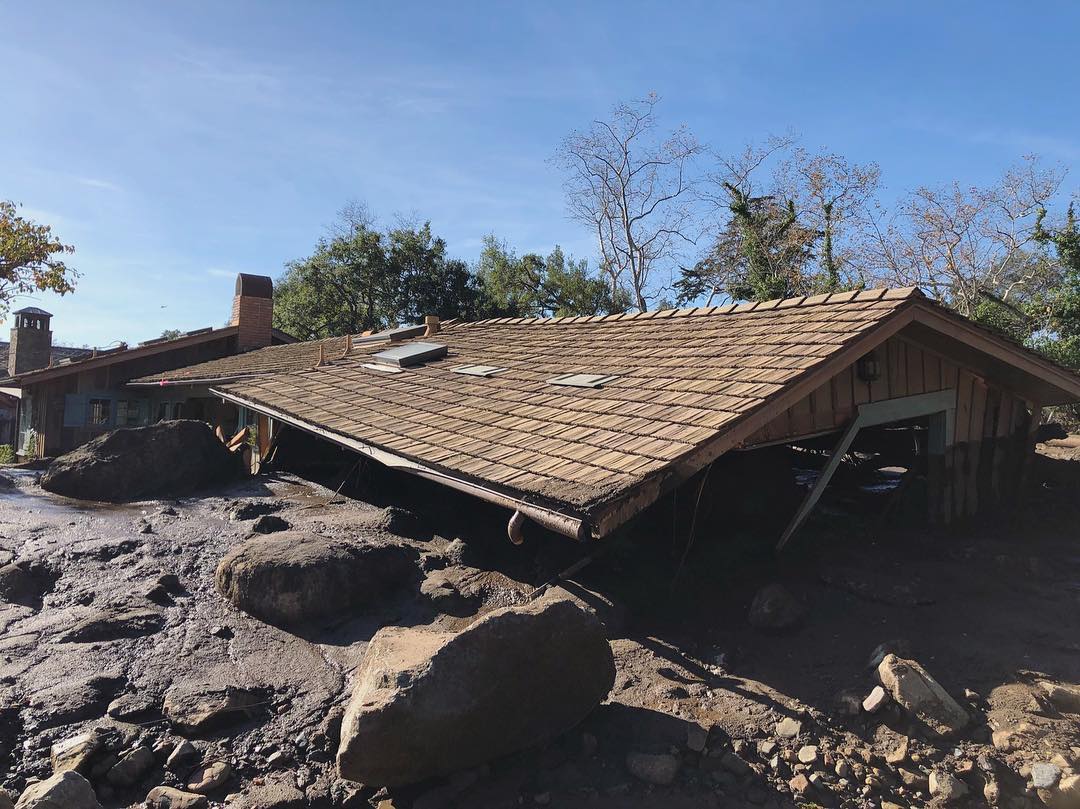
MacDonald said he and other Randall property owners met in May with county Flood Control officials and talked about the possibility of selling their land for a future debris basin. Separately, he said, they also sat down with local architects and some neighbors on Glen Oaks and East Valley to consider what to do.
“This is a historic challenge, and we’ve been told the county doesn’t have much in the way of budget,” MacDonald said, adding that he and his neighbors have been advised “to seek a political solution on our own as a group and seek funding for the area and more help from the federal government …
“We might face a situation where we’re offered for our land to be used as a debris basin. That’s been discussed by the county as a possibility. If that were to be the best outcome for Montecito and for us, we might take that option.”
As recently as last June, the San Ysidro Creek debris basin was slated for demolition in 2019 to help restore endangered steelhead trout on the South Coast. Under the circumstances, that plan has been abandoned. The county is now applying for a $5.6 million FEMA grant to expand the capacity of three debris basins on San Ysidro, Montecito, and Romero creeks.
One option, county Flood Control officials said, would be to construct concrete inlet structures in each of these basins like the one on the Gobernador Creek debris basin in the mountains above Carpinteria. It traps large rocks but allows mud and gravel to flow through, increasing capacity and creating better conditions for fish passage.
The county would pay $1.9 million toward the project; the total cost would be $2.5 million per basin. The application is due on September 4, officials said, and may take six months to process.
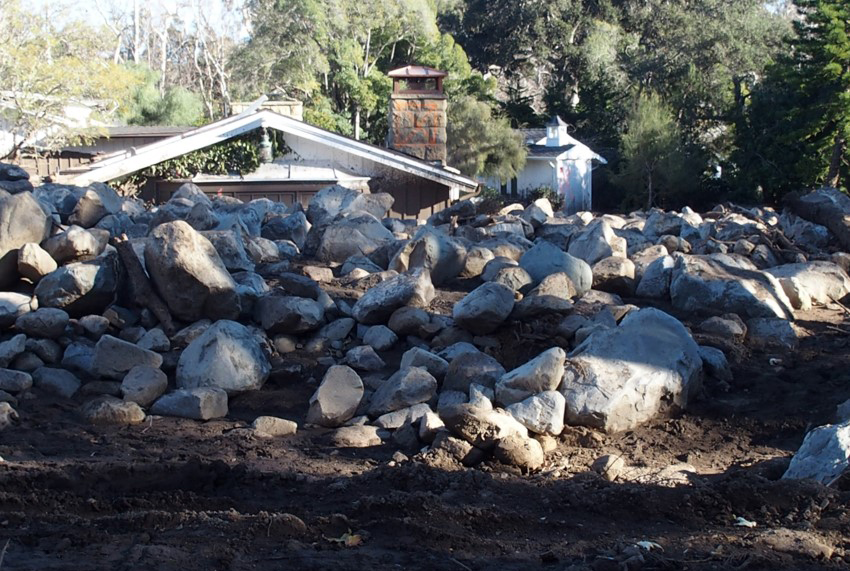
“We simply do not know what we’re going to end up with,” said Jon Frye, county Flood Control engineering manager.
The debris basin on San Ysidro Creek is one of the smallest on the South Coast; any expansion there is constrained by a tight canyon and a narrow access road. A series of smaller basins downstream “could accomplish good things,” Frye said. But, he cautioned, “It’s premature to be talking about specific properties.”
In addition to the debris basin grant, Frye said, the county has asked the state to lift the $5 million cap on the FEMA funds the county can apply for to purchase land.
County Supervisor Das Williams, who represents Montecito, said that the county would like to widen the creeks at some locations, in addition to potentially building new basins.
“I consider it an imperative to increase the flood control capacity of the creeks that we have,” Williams said. “The realistic scenario is that philanthropists buy the land and we build the projects. It starts with the property owner having realistic expectations about how much the land is worth at this point. Perhaps it can be sold at a discounted rate to get a tax deduction.
“At these sites where it’s flooded more than once, it makes you wonder. I don’t want to be in the position of approving buildings people die in. If people are ready to sell and there’s philanthropy to buy — even buy easements on land for safety in the community — we want to facilitate that.”
Whatever happens, the neighbors should keep talking to each other, said Victoria Riskin, who has decamped with her husband, David Rintels, to their vacation home on Martha’s Vineyard. When the neighbors met for the first time after January 9, Riskin said, “we just hugged and it was like finding fast friends.
“I was grateful for the tone and the spirit,” she said. “We’ll have to make a collective decision. What one does affects another. Some of us have lived on this street for a long time.”
Meanwhile, the owner of a house at 640 Randall, the only home on the road that was not destroyed on January 9, is moving ahead with repairs and renovations.
The property was purchased in 2016 for $3.4 million by Ronald Daniels, president of The Johns Hopkins University. Currently, county officials said, Daniels is the only owner building a new structure in the Montecito disaster zones. Records show that he obtained a permit for an interior remodel on January 3 and an “accessory dwelling unit” on January 25, having completed much of the permitting process last year. Daniels’ staff said last week that he was unavailable for comment.
Lost and Found,
Among the stranger experiences of being a survivor are the little things that bring back the enormity of what happened on January 9. Conrad-Armstrong said she didn’t cry for months until she “lost it” one day when she walked into Home Depot and saw a plastic wading pool on display. It reminded her of the happy days when the neighborhood dogs would splash about on her lawn, she said.
Riskin said she panicked in the aftermath of January 9 when she lost a pair of glasses.
“I’d lost so much, I couldn’t stand to lose anything else,” she said. “There’s so much post-traumatic stress in ways that people can’t fully realize.”
Among all that’s lost, a few things have been found. Amazingly, Conrad-Armstrong’s 23 turtles survived the January 9 disaster; some are back in the creek and some were taken to Alice Keck Park gardens.
Karen MacDonald got back her wedding veil, which some strangers found in a plastic bag along a Montecito trail.
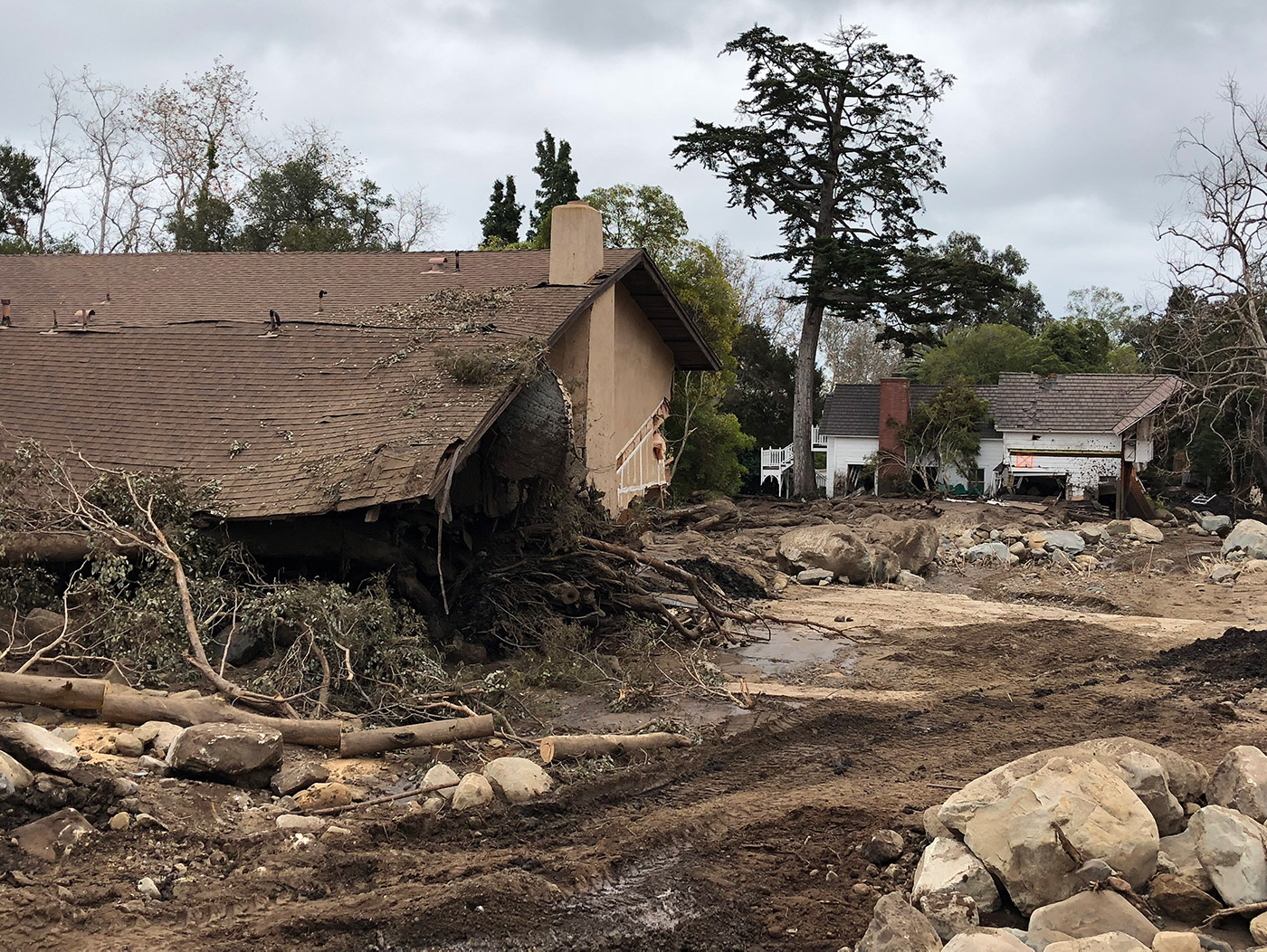
Upstairs in Riskin’s ruined home were all of her notes and photos, intact, for a book she is writing about her famous Hollywood parents, the actress Fay Wray and screenwriter Robert Riskin. Rintels retrieved a prized possession from the mud — a page of the Gutenberg Bible about his namesake, King David — and rushed it to the Huntington Library in San Marino, California, for cleaning.
Riskin is a board member emeritus of Human Rights Watch, an international nonprofit organization, and she is familiar with crises such as the severe drought in northern Kenya, where lakes are drying up and people are losing their livelihoods. But she never expected that she would be among the victims of a disaster linked to severe drought in California.
“You just think, it will never happen to me,” Riskin said. “What responsibility does a government have to mitigate or help people adapt to these events? It’s a template for what we’re facing in the future. If we can learn some realistic lessons, perhaps we can be more prepared for the turbulent effects of climate change.”



